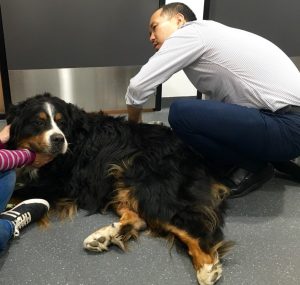Has your regular vet been unable to find the cause of the limp?
Are current treatments not improving your dog’s lameness?
At Southern Animal Health, we have a particular focus on diagnosing and treating lameness in dogs. Several of our vets (Dr Karin Davids, Dr Mike Voyce, Dr Marcus Hayes) have a special interest in canine musculoskeletal problems, as well as many years of experience in ‘hard to diagnose’ lameness cases. We are also proud to provide a number of treatment protocols and surgical options that many other veterinary clinics are not able to offer.
How is canine lameness diagnosed?
The starting point for us is to always have a discussion with you to get a full history of your dog’s lameness and symptoms, and then to perform a full clinical examination of your dog. This may also involve observing your dog walking and running. Sometimes we can get our answer within this initial consultation and examination, and other times further tests may be required. At Southern Animal Health we can provide the following diagnostic tests:
* Radiology (Xrays)
* Ultrasound
* CT scan (Drop your pet off at our hospital and we will transport him/her to and from the CT facility, have the scan performed, and then discuss the results with you afterwards)
* Joint fluid collection and analysis
* Diagnostic joint blocks
* Arthroscopy – Dr Karin Davids will soon be offering this service but until then, we can organise a specialist to perform arthroscopy at our hospital, (should your dog require it)
What different options are available for treatment of my dog’s lameness?
* Medications – There are many different anti-inflammatory and pain killer medications that we can use in either liquid, tablet or injectable form.
* Intraarticular medication (Injection of medication directly into the joint)
* Platelet rich plasma (PRP) – This can be used for treatment of osteoarthritis and some ligament/tendon injuries
* Splints/bandages/support braces
* Acupuncture
* Surgery – We offer a comprehensive surgical service for treatment of orthopaedic injuries including Advanced Fracture Repair, Tightrope Surgery and TPLO for cruciate ligament injuries, Juvenile Pubic Symphysiodesis (JPS) for early intervention of Canine Hip Dysplasia and Hip Joint Denervation for treatment of chronic hip pain
* Rehabilitation Therapy – A series of muscle massage techniques and strength building exercises may help in your dog’s recovery. We teach you how to do these at home on a regular basis
Common Causes of Canine Lameness
This list is by no means comprehensive, but some of the most common problems that we see include:
* Cruciate ligament disease/injury
* Luxating patella (Dislocating kneecap)
* Hip dysplasia
* Elbow dysplasia
* Medial shoulder instability
* Hip joint dislocation
* Spine problems and disc disease
* Fractures
* Soft tissue injuries/muscle sprains
* Growth plate injuries
* Angular limb deformities
Our main objective is to do all that we can to diagnose and resolve your dog’s problem so that they can continue to live an active and comfortable life. In hard to answer cases, we cross-refer within our hospital for second opinions and often have team meetings to discuss the best management plan for your dog.

